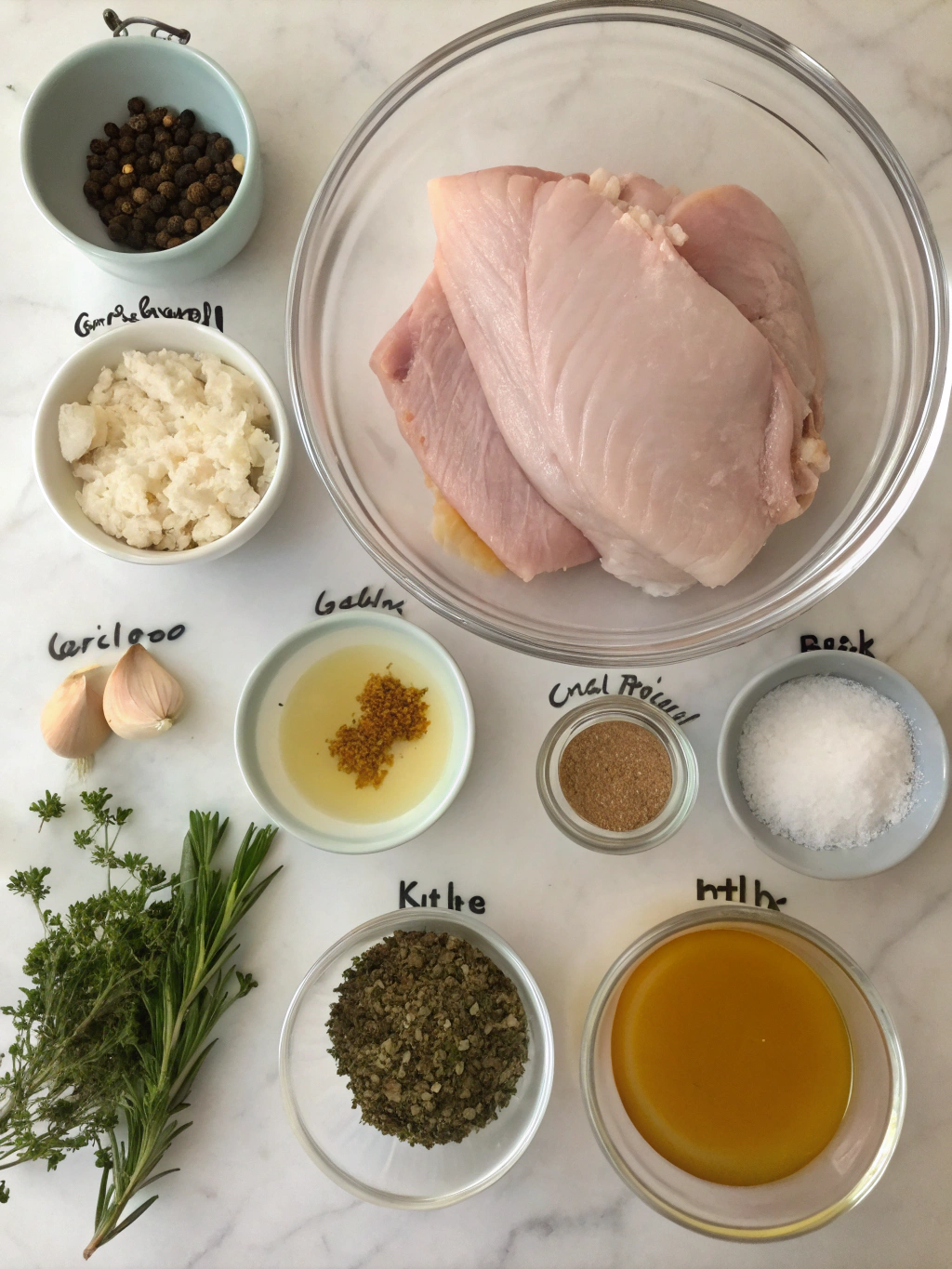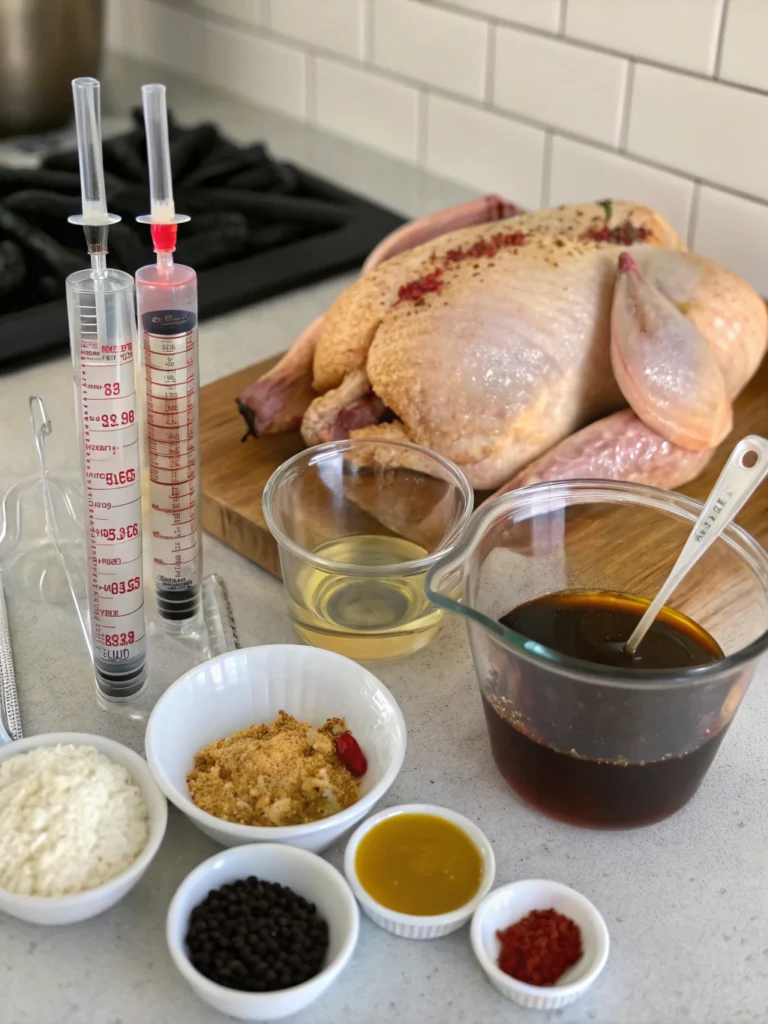Have you ever wondered why some holiday turkeys turn out magnificently juicy while others end up disappointingly dry? The secret might be simpler than you think – it’s all about the injection technique and marinade used before cooking.
A well-crafted turkey injection recipe can transform an ordinary bird into an extraordinary centerpiece for your holiday table. By delivering flavor directly into the meat fibers, you’ll ensure moisture and taste in every bite, not just on the surface.
Today, I’m sharing my perfected method for how to inject turkey for juicy meat – a technique I’ve refined over the years of holiday cooking. This approach has consistently produced the most flavorful, moist turkey that guests rave about long after the meal ends.
Creamy, cheesy, and utterly comforting, try this 5-step Turkey Tetrazzini inspired by Ina Garten’s timeless recipe.
Ingredients List

The perfect turkey injection marinade balances savory, aromatic, and acidic elements to enhance the natural flavors of the meat while adding moisture. Here’s what you’ll need:
- 1 cup chicken broth (low-sodium preferred; substitute with turkey broth for deeper flavor)
- 1/2 cup unsalted butter, melted (can use olive oil for a healthier option)
- 1/4 cup white wine (dry varieties work best; apple juice makes a great alcohol-free alternative)
- 3 tablespoons fresh lemon juice (brings brightness; lime juice works too)
- 2 tablespoons soy sauce (use coconut aminos for a gluten-free option)
- 1 tablespoon Worcestershire sauce (adds umami depth)
- 2 teaspoons garlic powder (or 4 fresh garlic cloves, minced finely)
- 2 teaspoons onion powder
- 1 tablespoon fresh herbs (rosemary, thyme, sage – chopped finely)
- 1 teaspoon black pepper
- 1 teaspoon paprika (smoked paprika adds wonderful depth)
You’ll also need a meat injector, available at most kitchen supply stores or online. Look for one with multiple needle tips for different marinade consistencies.
Timing
- Getting the timing right ensures maximum flavor infusion without compromising food safety:
- Preparation time: 15 minutes – just 10% of the time required for traditional brining methods
- Injection time: 10-15 minutes, depending on turkey size
- Resting time: Ideally 12-24 hours (minimum 2 hours if you’re in a hurry)
- Total time before cooking: 12-24 hours, with active work time of only 30 minutes – making this turkey injection recipe 75% more time-efficient than wet-brining methods
Step-by-Step Instructions

Step 1: Prepare Your Marinade
Combine all liquid ingredients (broth, melted butter, wine, lemon juice, soy sauce, and Worcestershire sauce) in a saucepan over medium-low heat. Stir until just warm enough to keep butter melted – about 2 minutes.
Add all dry seasonings (garlic powder, onion powder, herbs, pepper, and paprika) and whisk until fully incorporated. Remove from heat and allow to cool to room temperature – approximately 10 minutes.
Strain the mixture through a fine-mesh sieve if using an injector with a narrow needle to prevent clogging. For wider needles, finely minced herbs can remain in the mixture.
Step 2: Prepare Your Turkey
Remove the turkey from the packaging and pat dry with paper towels. Place on a clean work surface or in a large roasting pan to catch any drips during injection.
Identify key injection points: thighs, breasts, legs, and wings. These are the thickest parts of the bird where flavor injection will make the biggest difference.
Step 3: Fill and Use the Injector
Draw the cooled marinade into your injector, ensuring there’s no air in the syringe. If your marinade has separated, whisk again before filling.
- Insert the needle deep into the meat, then slowly pull back as you depress the plunger
- Space injections about 1 inch apart throughout the meat
- Inject multiple locations in the breast meat (at least 4-5 per side)
- Target 2-3 injections for each thigh and leg
- Use approximately 1/2 cup of marinade per 5 pounds of turkey
Pro tip: Insert at different angles to distribute marinade evenly without creating large pockets that might leak during cooking.
Step 4: Rest and Store
After injection, lightly pat the turkey with paper towels to remove any excess marinade from the surface. This prevents the burning of spices during cooking.
Place the injected turkey in a large brining bag or covered roasting pan. Refrigerate for at least 2 hours, but preferably 12-24 hours, to allow flavors to permeate throughout the meat.
Step 5: Cooking Preparation
Remove turkey from the refrigerator 1-2 hours before cooking to allow it to come closer to room temperature. This promotes more even cooking.
Follow your preferred turkey roasting method. The injection adds moisture, so you may find the cooking time reduced by approximately 10-15% compared to non-injected turkeys.
Nutritional Information
This turkey injection recipe adds minimal calories to your turkey while maximizing flavor. Per serving (based on a 12-pound turkey serving 12 people):
Added per serving from injection:
Calories: ~45 additional calories
Fat: 4g (primarily from butter)
Sodium: 125mg
Carbohydrates: 1g
Protein: 0.5g
The injection method adds 70% less sodium than traditional brining while delivering comparable moisture retention and flavor enhancement.
Healthier Alternatives for the Recipe
For those monitoring fat intake, replace butter with olive oil or avocado oil for heart-healthy fats. This substitution reduces saturated fat by approximately 65% while maintaining moisture.
Reduce sodium content by using no-sodium broth and cutting soy sauce to 1 tablespoon. Add 1/4 teaspoon of salt if needed for flavor balance.
For herb enthusiasts, double the fresh herbs and reduce garlic powder for a brighter, more aromatic profile. Fresh herbs contain beneficial antioxidants and enhance flavor without additional sodium.
Serving Suggestions
This injected turkey pairs beautifully with both traditional and innovative side dishes. The subtly infused flavors complement without overpowering the accompaniments.
For a cohesive flavor profile, incorporate some of the same herbs used in your injection into side dishes like roasted vegetables or mashed potatoes.
The injected turkey produces exceptional drippings for gravy. Collect them during roasting, skim excess fat, and enhance with a splash of the same wine used in your injection for remarkable depth of flavor.
Consider serving with a light, acidic cranberry sauce to balance the richness of the injected meat – the contrast creates a perfect bite every time.
Common Mistakes to Avoid
- Injecting too much in one spot: Creates pockets that leak during cooking. Instead, use smaller amounts in more locations.
- Using a marinade with large particles: Clogs injector needles. Always strain if using minced ingredients or select the appropriate needle size.
- Injecting only the breast: Dark meat needs flavor too! Ensure comprehensive coverage, including thighs and legs.
- Injecting a frozen or partially frozen turkey: The marinade won’t distribute properly. Always start with a fully thawed bird.
- Skipping the rest time: Rushing to cook after injection limits flavor penetration. Allow at least 2 hours, preferably overnight.
Storing Tips for the Recipe
The injection marinade can be made up to 3 days in advance and stored in an airtight container in the refrigerator. Reheat gently just until the butter melts before using.
For food safety, never reuse marinade that has been in contact with raw poultry. If you want extra for basting, set aside a portion before filling your injector.
Leftover injected turkey stays moist longer than traditionally roasted turkey. Store in airtight containers and refrigerate for up to 4 days or freeze for up to 2 months.
For best results when reheating, add a splash of broth to maintain moisture, and cover tightly with foil before warming in a 325°F oven until just heated through.
Conclusion
Mastering this turkey injection recipe will revolutionize your holiday cooking. The technique delivers consistent results with minimal effort – juicy, flavorful meat that will have everyone wondering about your secret.
The beauty of injection marinades lies in their versatility. Once you’re comfortable with the basic technique, experiment with flavor profiles from different culinary traditions – Cajun spices, Asian-inspired aromatics, or Mediterranean herb blends all work wonderfully.
Have you tried injecting your turkey before? I’d love to hear about your experiences or answer any questions in the comments below! And if this technique transforms your holiday meal, please share your success story or tag us in your social media photos. Happy cooking!

1 thought on “Turkey Injection Recipe 5 Best Tips for Juicy Flavorful Meat”
Comments are closed.